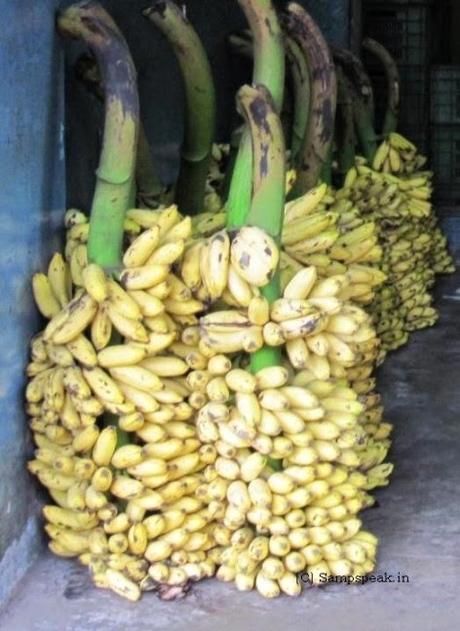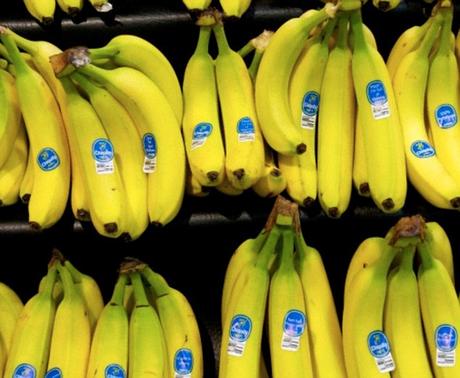 To some, they are the best fruits
on earth. It provides spurt of energy and many athletes take it during their
games. The healthy nutrients and it
being the most sought after fruit of common man, cannot however be denied. There are so many varieties but almost all of
them are ‘yellow bananas’ here – there is also the ‘green
banana’ – in one way green is unripe …having starchy texture and inedible – but
green banana is a variety – generally big in size.
Banana, that delicious fruit is
the common name for herbaceous plants of the genus Musa ~ interestingly,
bananas do not grow from a seed but from a bulb or rizhome. Once the alluvial
belt alongside the river Kaveri in Thanjavur, Trichy, Thiruvaiyaru flourished
with banana plantation – now with water not fully flowing – understand that the
cultivation too has suffered. Down south
in India, eating in a banana leaf is fulfilling and traditionally food is
served on big banana leaf on ceremonial occasions.
Bananas are the world’s most
popular fruit – but they have a short shelf-life. Hence cannot be stored for longer times and
sometimes could go waste when kept in open for many days. Extending their shelf-life could mean that they
are bought more [or in one way – is it that their sales are higher, only
because they have a shorter life !!]
Bananas are harvested when they
are green. In many places, they are then treated with a gas called ethylene,
which is naturally produced by ripening fruit.
MailOnline reports that Scientists have now developed a 'natural dip'
that can extend the life of the ripe fruit by up to two days – doubling their
shelf life of around two to three days.The breakthrough could help reduce food
waste.
Bananas turn yellow around four
to five days after the ethylene gas treatment. Once yellow, bananas are considered
unsuitable for sale after two to three days.So just an extra couple of days
makes a big difference to shops selling the fruit.The dip called LPE, a
phospholipid, naturally occurs in egg yolks and soya beans.Zienab Ahmed from
South Valley University in Egypt and JiwanPalta from the University of
Wisconsin-Madison carried out the research, published in HortScience.The
authors said: ‘Previous studies conducted in our laboratory have demonstrated
that both pre- and post-harvest application of lysophosphatidylethanolamine
(LPE) can retard aging and improve shelf life of various fruits.
To some, they are the best fruits
on earth. It provides spurt of energy and many athletes take it during their
games. The healthy nutrients and it
being the most sought after fruit of common man, cannot however be denied. There are so many varieties but almost all of
them are ‘yellow bananas’ here – there is also the ‘green
banana’ – in one way green is unripe …having starchy texture and inedible – but
green banana is a variety – generally big in size.
Banana, that delicious fruit is
the common name for herbaceous plants of the genus Musa ~ interestingly,
bananas do not grow from a seed but from a bulb or rizhome. Once the alluvial
belt alongside the river Kaveri in Thanjavur, Trichy, Thiruvaiyaru flourished
with banana plantation – now with water not fully flowing – understand that the
cultivation too has suffered. Down south
in India, eating in a banana leaf is fulfilling and traditionally food is
served on big banana leaf on ceremonial occasions.
Bananas are the world’s most
popular fruit – but they have a short shelf-life. Hence cannot be stored for longer times and
sometimes could go waste when kept in open for many days. Extending their shelf-life could mean that they
are bought more [or in one way – is it that their sales are higher, only
because they have a shorter life !!]
Bananas are harvested when they
are green. In many places, they are then treated with a gas called ethylene,
which is naturally produced by ripening fruit.
MailOnline reports that Scientists have now developed a 'natural dip'
that can extend the life of the ripe fruit by up to two days – doubling their
shelf life of around two to three days.The breakthrough could help reduce food
waste.
Bananas turn yellow around four
to five days after the ethylene gas treatment. Once yellow, bananas are considered
unsuitable for sale after two to three days.So just an extra couple of days
makes a big difference to shops selling the fruit.The dip called LPE, a
phospholipid, naturally occurs in egg yolks and soya beans.Zienab Ahmed from
South Valley University in Egypt and JiwanPalta from the University of
Wisconsin-Madison carried out the research, published in HortScience.The
authors said: ‘Previous studies conducted in our laboratory have demonstrated
that both pre- and post-harvest application of lysophosphatidylethanolamine
(LPE) can retard aging and improve shelf life of various fruits.
 ‘In this study we investigated
the possibility of improving shelf life of banana fruit by a postharvest dip in
LPE.’Bananas that were 75 per cent green were dipped in the LPE solution for 30
minutes and then observed for a five days at room temperature.The treatment was
applied to 50 uniform bananas from different bunches.The authors said: ‘Five
days after dip treatment, the fruit treated with LPE were firmer and thicker as
compared with the untreated control.’ The Scientists now claim that the
extention by up to two days – doubling their shelf life of around two to three
days - could help reduce food waste in supermarkets.
Would sound confusing and out of
place for our market – where color of the banana is never the criteria and in
fact all bananas are yellow – only when they become soggy and putrid, they are
considered unsaleable here.
With regards – S. Sampathkumar
‘In this study we investigated
the possibility of improving shelf life of banana fruit by a postharvest dip in
LPE.’Bananas that were 75 per cent green were dipped in the LPE solution for 30
minutes and then observed for a five days at room temperature.The treatment was
applied to 50 uniform bananas from different bunches.The authors said: ‘Five
days after dip treatment, the fruit treated with LPE were firmer and thicker as
compared with the untreated control.’ The Scientists now claim that the
extention by up to two days – doubling their shelf life of around two to three
days - could help reduce food waste in supermarkets.
Would sound confusing and out of
place for our market – where color of the banana is never the criteria and in
fact all bananas are yellow – only when they become soggy and putrid, they are
considered unsaleable here.
With regards – S. Sampathkumar
31st Oct 2o15

